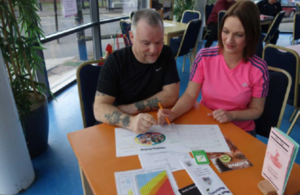Ways to Wellness Newcastle for people with long term conditions
Social prescribing helps patients to manage their long term conditions through one-to-one support from a link worker.

Summary
Participating GP practices in Newcastle can refer patients to a Ways to Wellness link worker, trained in behaviour change methods, who then works with the person one-to-one to identify health and wellness goals that are meaningful to them. Eligible patients are between 40 and 74 years of age, with a diagnosis of 1 of 8 long term conditions such as diabetes or heart disease.
Background
The west of Newcastle upon Tyne, a population of 132,000, includes some of the most deprived areas in England. There is evidence that people in lower socio-economic groups tend to suffer proportionately more, and earlier in life, with long term conditions (LTCs), have poorer health outcomes and use more health service resources.
The aim of the project is to help people overcome barriers to managing their long term health conditions. Patients will manage their daily lives better, look forward to a healthier and longer life expectancy and will make less use of hospital services, their GP services and prescription drugs.
The project is the culmination of several years of work by different organisations in the west of Newcastle upon Tyne to pilot services to improve peoples’ health. It developed through the guidance of the steering group and through consultation with the community. GP practices in Newcastle West offered social prescribing in a small way for some years and wanted to provide this to more patients, in a more organised way.
The service is funded by a Social Impact Bond investment from Bridges Ventures. Newcastle Gateshead Clinical Commissioning Group (CCG), The Big Lottery Fund and the Cabinet Office.
What was involved?
Seventeen participating GP practices in the west of Newcastle can refer patients to a Ways to Wellness link worker, trained in behaviour change methods, who then works with the person one-to-one to identify health and wellness goals that are meaningful to them. The link workers connect the person, when indicated, to community and voluntary groups and resources in their area.
The shared decision-making process and supportive coaching relationship established with the link worker enables patients to be equal partners in managing their health. People are supported to develop sustainable healthy behaviours, and learn to self-manage their conditions confidently to live healthier and more fulfilling lives, while reducing their dependency on traditional health services.
Ways to Wellness is unique in a number of ways, including:
- scale of social prescribing (linking people with sources of support in the local community)
- integration with GP practices
- based within the community and voluntary sector
- social impact bond (SIB) investment funding (funding for improved social outcomes that result in public sector savings)
- outcome based contracting and commissioning
- development of a robust financial model and dedicated management information system
- funding focused on link worker capacity (rather than activities) to invest in one-to-one patient support
- establishment of a new organisation, Ways to Wellness, with a strong board of directors, to steer the pioneering work
There have been issues with getting training accredited and assessing skills and competencies
Outcomes
As this is a 7 year project, some of the expected outcomes are:
- improvements in patient self-management
- improvements in patient’s health compared with predictions
- reduction in hospital visits and bed days
- reduced visits to GPs
- reduced reliance on prescription drugs for some conditions (such as those for depression)
All link workers use the Well-being Star to support and measure patient’s progress. In Ways to Wellness’ first year (April 2015 to March 2016), over 1,100 patients were referred to the service, of which over 300 patients completed a second assessment of their wellbeing. Compared to when they started with Ways to Wellness, these patients, on average, have improved their wellbeing by 4 points on the Well-being Star, which is considered a significant improvement. The areas where patients reported the most significant improvements in wellbeing are:
- work, volunteering and other activities
- lifestyle
- feeling positive
Nearly 3 years into the project, there have been 4,000 patient referrals.
The longer term outcomes around savings to secondary care costs are yet to be realised.
What works well?
There have been some major factors contributing to the success of the project so far. These include:
- relationship building with key stakeholders including GPs, and community and voluntary sector which led to excellent referral rates from GPs to the project
- each of the 4 providers covering a geographical area and a cluster of practices has enhanced relationship building and generated shared learning between the providers
- the development of the dedicated management information system
- the commitment of the steering group to drive the programme
Some of the challenges faced included:
- negotiating the standard NHS contract which is not designed for an innovative outcomes based approach
- dealing with information governance issues / sharing of data
- political factors around persuading funders to get on board and working in partnership with voluntary and community sector
The most important factor to was to establish a group of strong willed, like-minded people with local influence and credibility who are prepared to push perceived boundaries.
Next steps
The project doesn’t complete until 2022 and the work is ongoing. The next step is to look at secondary care data trends.
Further information
For more information please contact:
- Chris Drinkwater, Chair, Ways to Wellness
- Dr Guy Pilkington, Assistant Chair, Newcastle Gateshead CCG
- Philippa Dodds, Delivery Project Lead (Newcastle), Newcastle Gateshead CCG